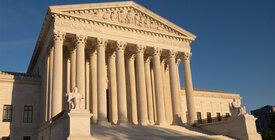
Lifetime Tenure for Supreme Court Justices Has Outlived Its Usefulness
While letting justices serve during “good behavior” was designed to encourage impartiality, it now tends to promote the opposite effect. Term limits offer one solution to this problem.

Part of
Preserving an independent judiciary is a fundamental goal of American constitutionalism. As public opinion polls repeatedly demonstrate, Americans now doubt this ideal is being fulfilled. Crucial Supreme Court decisions appear inherently political in nature, with individual justices voting their partisan preferences. The behavior of the justices has compounded this suspicion. Though they often convey a public image of their collegiality, much evidence cuts in the opposite direction.
These qualms have led many observers to believe that the Court badly needs reform to fulfill its intended role in our constitutional system, and various reforms have been proposed. Requiring the justices to abide by a serious code of ethics is one. Another would be to expand the size of the Court, which Congress can legally do, to seat one justice for each of the nation’s 12 judicial circuits.
By far the most interesting proposal, however, is the idea that the justices should serve fixed terms, with 18 years appearing to be the most popular suggestion. This would promote a badly needed rotation on the Court, where the entire appointments process has long entrenched a durable conservative majority.
This essay will not propose a political strategy to secure that end. What I will argue instead is that a fixed term for the justices would indeed better serve the founding generation’s ideas and ideals of judicial independence. This claim rests on two historical sources. One reflects the legacy of English precedent, the other the impact of Montesquieu’s discussion of the concept of the separation of powers in his enormously influential work, The Spirit of the Laws.
The story begins in 1701, when Parliament passed the Act of Settlement to ensure that Britain would remain a Protestant monarchy after the death of Queen Anne, the last of the Stuart dynasty. But this statute also had some supplemental provisions. Its seventh clause altered the nature of judicial tenure in England. Royal judges had previously served at the pleasure of the Crown. In the 17th century, royal judges had often advanced the authoritarian agenda of the Stuart monarchy. James II, the king deposed in the Glorious Revolution of 1688, had personally purged judges who refused to do his bidding. Under the Act of Settlement, judges would henceforth serve on good behavior to be removeable only on cause by Parliament. Under the new Hanoverian dynasty, the judges would no longer serve as lackeys of the Crown.
But this fundamental shift in judicial tenure did not apply to Britain’s overseas provinces in North America. There judges still served at the pleasure of the Crown, and this disparity reinforced the colonists’ belief that they were still second-class subjects within the British empire.
The second major development was the publication in 1748 of Montesquieu’s The Spirit of the Laws. In the famous Book XI of that seminal work, Montesquieu observed that that “there is one nation in the world whose constitution has political liberty for its direct purpose.” That nation was Britain, and Montesquieu explained this achievement by describing how the separation of powers operated to secure the liberty of the citizen. In that description, he became the first theorist to identify an independent judiciary as a distinct branch of governance. He thus gave Americans a principled basis for denouncing the insecure tenure of royal judges.
Montesquieu’s influence became evident when Americans began drafting new state constitutions in 1776. Many of these documents affirmed the maxim that the revolutionaries associated with The Spirit of the Laws. Article VI of the Maryland declaration of rights provides a typical example: “That the legislative, executive and judicial powers of government, ought to be forever separate and distinct from each other.” Other texts stated that each department should exercise only its own distinct form of power, but not that belonging to the other two departments.
Yet this general loyalty to Montesquieu’s maxims did not clearly map the working distribution of powers across the departments. State legislatures, for example, continued to entertain petitions asking them to resolve disputes that were essentially judicial in nature.
Nor did the first generation of American constitution writers completely agree on judicial tenure. Virginia and Massachusetts made “good behavior” the basis of tenure for their highest courts, but Pennsylvania and New Jersey set terms of seven years. Other states left the matter for legislative determination. Before 1776 the real complaint was to protect colonial judges against royal power. Protecting them against the people’s elected representatives was a less urgent matter.
What did count, after 1776, were two other developments. First, the demands of the Revolutionary War required legislatures to legislate far more actively. Many of the statutes were burdensome in ways that colonial era laws had never been, and this surge in activity gave the courts new importance. Second, many Americans began to think of written constitutions as a higher form of law, superior in authority to ordinary acts of government. That perception helped to initiate the practice of judicial review, making courts potential interpreters and guardians of constitutions.
Roughly half a dozen of such cases appeared in the states in the 1780s. The framers were well aware of them, and alert to their implications. They alluded to judicial review during the debate over the council of revision, a joint executive-judicial body that would have a limited veto over national and state legislation. And the Supremacy Clause of Article VI empowered state judges to exercise judicial review over acts of their own legislatures that conflicted with the Constitution, national laws, and treaties. What state judges had to be empowered to do explicitly, federal judges would do implicitly.
The idea that federal judges should serve during “good behaviour” was uncontroversial. That proposal first appeared in the ninth resolution of the Virginia Plan, and it never provoked any criticism thereafter. Alexander Hamilton’s Federalist No. 78 helps us to better understand the framers’ commitment to tenure during good behavior. There we learn that tenure during good behavior was deeply interwoven with judicial review.
Hamilton opened his discussion by saying three topics needed review. The first, the mode of appointment — presidential nomination, senatorial confirmation — he covered in a single-sentence paragraph. The third topic, the partition of judicial power among multiple courts, required a careful, detailed description. The second topic, “the tenure by which they are to hold the places,” demanded something more: a substantive account of the judicial function under a written constitution.
Hamilton began this account with his famous portrayal of the judiciary as the “least dangerous” department. It possessed none of the resources the political branches enjoyed. “It may truly be said to have neither force nor will, but merely judgment.” For this situation to work, however, the judiciary must “remain truly distinct” from the other two departments. Here Hamilton invoked the wisdom of “the celebrated Montesquieu.” Tenure during good behavior would give judges the independence they needed to act conscientiously.
But all this was a prologue to Hamilton’s real argument. The most important question was to explain “the rights of the courts to pronounce legislative acts void.” Judges lacked the direct political authority that legislators enjoyed as the people’s elected representatives. How could they therefore acquire a superior voice? Hamilton resolved this “perplexity” with an elegant formula. The Constitution and the legislature both derive their power from the people. By its very nature the Constitution is the superior source of legal authority. Judges were therefore empowered to “ascertain its meaning” as well as the meaning of ordinary legislation. When there was a conflict between them, therefore, the Constitution must prevail, and judges, independently applying their learning, must enforce it.
Tenure during good behavior was a necessary condition to enable the judges to fulfill this responsibility. But history has since revealed that giving Supreme Court justices tenure during good behavior no longer provides the impartiality and independence that the framers intended to bestow. We now know that this procedure can produce two radically different ends. Its intended purpose was to recruit a skilled judiciary whose members would apply their individual judgment to decide the cases and controversies that came before them, on their merits. Today its manifest purpose seems quite different. If one can establish reliable criteria to vet the political preferences of potential judicial nominees, one can convert judicial agenda-shaping and decision-making into “a continuation of politics by other means,” to borrow a phrase from the Prussian military strategist Carl von Clausewitz. Perhaps our constitutional jurisprudence now owes more to Clausewitz than it does to Hamilton, Madison, or John Marshall.
Jack Rakove is the William Robertson Coe Professor of History and American Studies and Professor of Political Science, emeritus, at Stanford University.
More from the Perspectives on Supreme Court Term Limits series
-
A Transformed Supreme Court Requires Different Solutions
The Court has changed substantially since the 19th century, and the tradition of life tenure should be viewed in this historical context. -
Why Term Limits for Supreme Court Justices Make Sense
Term limits are good policy and can be implemented by statute, a former federal appeals court judge explains. -
Life Tenure Is a Rarity on State Supreme Courts
The U.S. Supreme Court should follow the example of 49 states, where justices don’t serve life terms.




